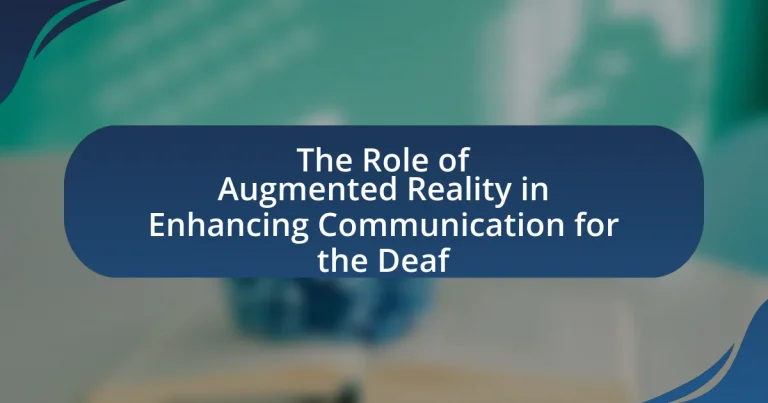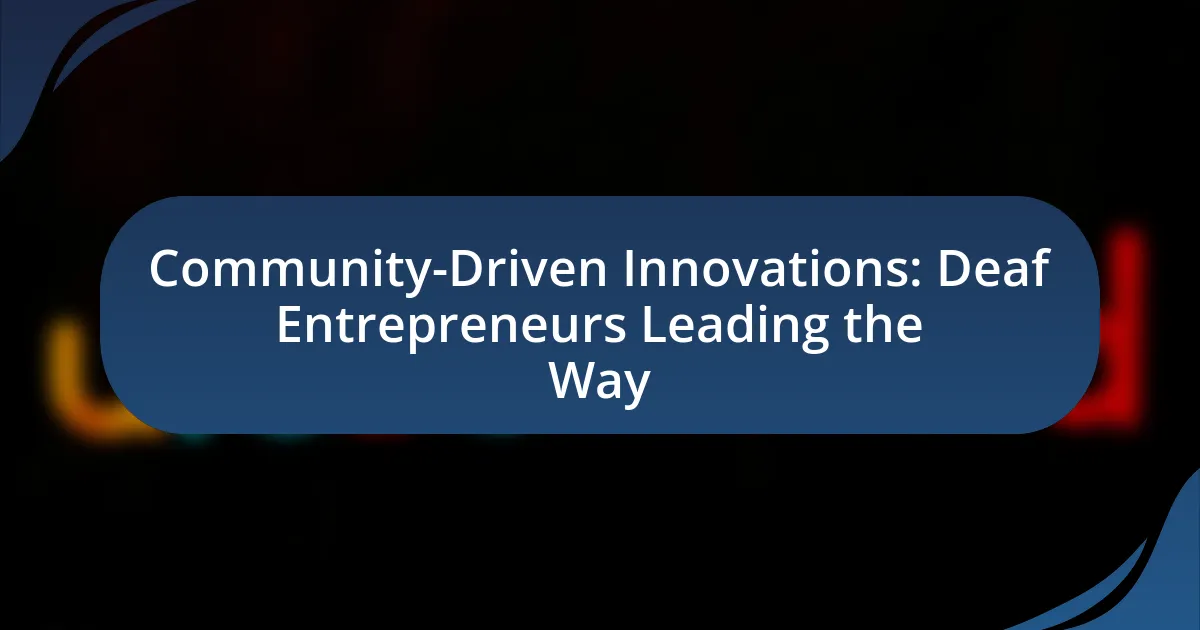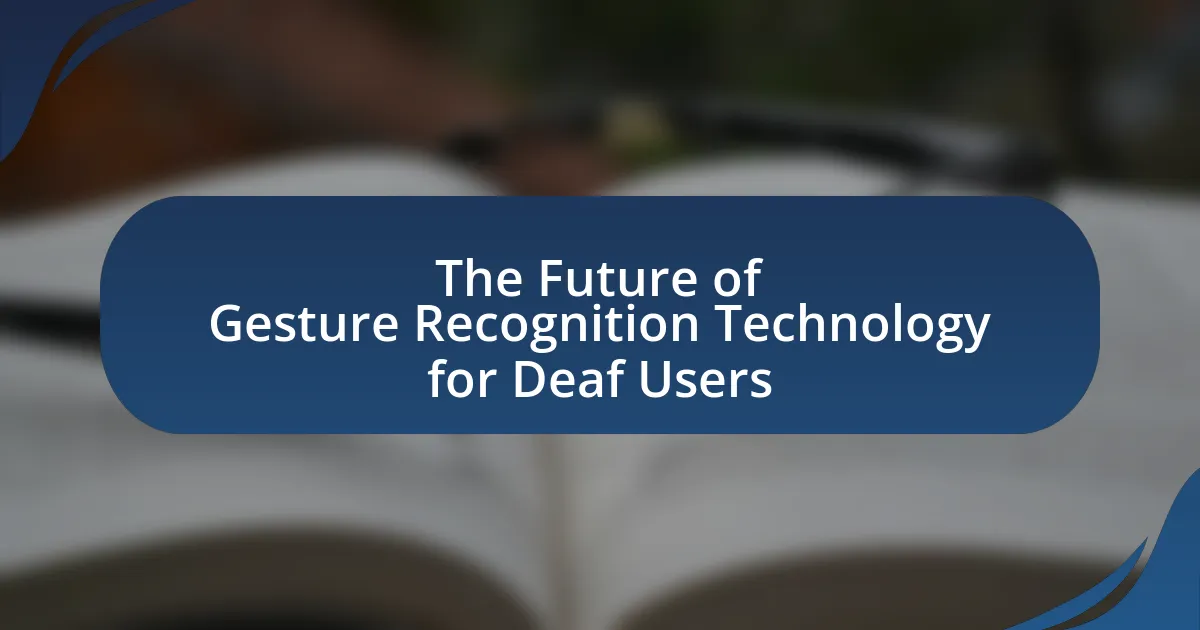Augmented Reality (AR) significantly enhances communication for the Deaf by providing visual aids that facilitate understanding and interaction. This technology overlays sign language interpretations, captions, and visual cues onto real-world environments, improving accessibility and comprehension in various settings, including educational and professional contexts. Key technologies involved in AR applications for the Deaf include computer vision, natural language processing, and gesture recognition, which collectively bridge communication gaps. The article explores the benefits of AR, current implementations, user feedback, challenges, and future developments, emphasizing the importance of collaboration with the Deaf community to create effective communication tools.
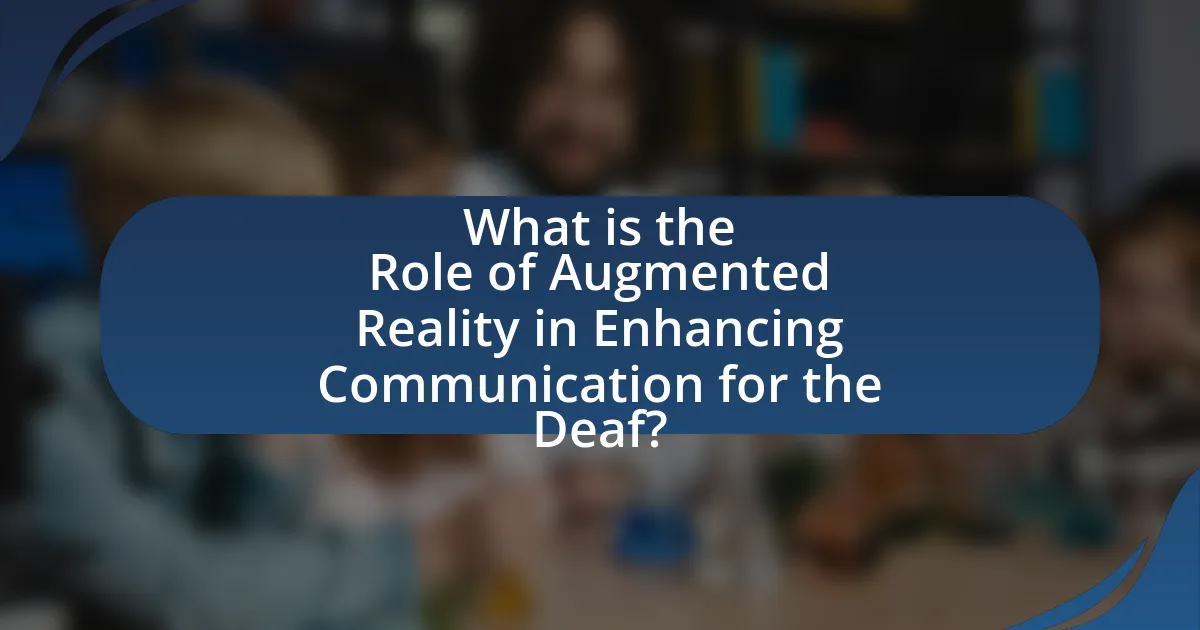
What is the Role of Augmented Reality in Enhancing Communication for the Deaf?
Augmented Reality (AR) plays a significant role in enhancing communication for the Deaf by providing visual aids that facilitate understanding and interaction. AR applications can overlay sign language interpretations, captions, and visual cues onto real-world environments, making communication more accessible. For instance, studies have shown that AR can improve the comprehension of spoken language through visual representations, allowing Deaf individuals to engage more effectively in conversations. Additionally, AR tools can assist in educational settings by providing interactive learning experiences that cater to the unique communication needs of Deaf students, thereby promoting inclusivity and participation.
How does Augmented Reality facilitate communication for the Deaf?
Augmented Reality (AR) facilitates communication for the Deaf by providing visual representations of spoken language through real-time text and sign language overlays. This technology enhances understanding by translating auditory information into visual formats, allowing Deaf individuals to engage more effectively in conversations. For instance, AR applications can display captions or sign language interpreters in the user’s field of view, making it easier to follow discussions in various environments, such as classrooms or public spaces. Studies have shown that AR can significantly improve comprehension and interaction for Deaf users, as it bridges the gap between spoken and signed communication, thereby fostering inclusivity and accessibility.
What technologies are involved in Augmented Reality applications for the Deaf?
Augmented Reality (AR) applications for the Deaf primarily involve technologies such as computer vision, natural language processing, and gesture recognition. Computer vision enables the detection and interpretation of visual information, allowing AR systems to overlay relevant content in real-time. Natural language processing facilitates the conversion of spoken language into text or sign language, enhancing accessibility. Gesture recognition technology interprets hand movements and signs, enabling seamless communication between Deaf users and their environment. These technologies collectively improve communication and interaction for the Deaf community by providing visual cues and real-time translations.
How do these technologies improve accessibility for Deaf individuals?
Augmented reality (AR) technologies improve accessibility for Deaf individuals by providing visual communication tools that enhance understanding and interaction. AR applications can overlay sign language interpretations, captions, or visual cues onto real-world environments, making it easier for Deaf individuals to engage in conversations and access information. For instance, studies have shown that AR can facilitate real-time translation of spoken language into sign language, allowing Deaf users to follow discussions in educational or professional settings more effectively. This integration of visual elements into everyday interactions significantly reduces communication barriers, thereby fostering inclusivity and participation for Deaf individuals in various contexts.
What are the key benefits of using Augmented Reality for Deaf communication?
The key benefits of using Augmented Reality (AR) for Deaf communication include enhanced visual engagement, improved accessibility to information, and real-time interaction. AR provides visual cues and contextual information that can facilitate understanding, making communication more effective for Deaf individuals. For instance, AR applications can overlay sign language interpretations onto real-world environments, allowing users to receive information in a more intuitive manner. Studies have shown that AR can significantly improve comprehension and retention of information among Deaf users, as it combines visual elements with interactive features, thus catering to their preferred communication style.
How does Augmented Reality enhance understanding of spoken language?
Augmented Reality (AR) enhances understanding of spoken language by providing visual context and cues that complement auditory information. This technology overlays digital content onto the real world, enabling users to see visual representations of spoken words, gestures, or sign language in real-time. For instance, AR applications can display subtitles or visual symbols that correspond to spoken dialogue, making it easier for individuals who are deaf or hard of hearing to grasp the meaning of conversations. Research has shown that integrating visual elements with auditory input significantly improves comprehension and retention of spoken language, as evidenced by studies indicating that multimodal learning approaches lead to better outcomes in language acquisition.
What role does visual representation play in Augmented Reality for the Deaf?
Visual representation is crucial in Augmented Reality (AR) for the Deaf as it facilitates effective communication by providing visual cues and information that replace auditory signals. AR applications can display sign language, captions, and visual symbols in real-time, enabling Deaf individuals to understand spoken language and interact with their environment more intuitively. For instance, studies have shown that AR can enhance learning and comprehension by presenting information visually, which aligns with the visual learning preferences of Deaf individuals. This integration of visual elements in AR not only improves accessibility but also fosters social inclusion by bridging communication gaps.
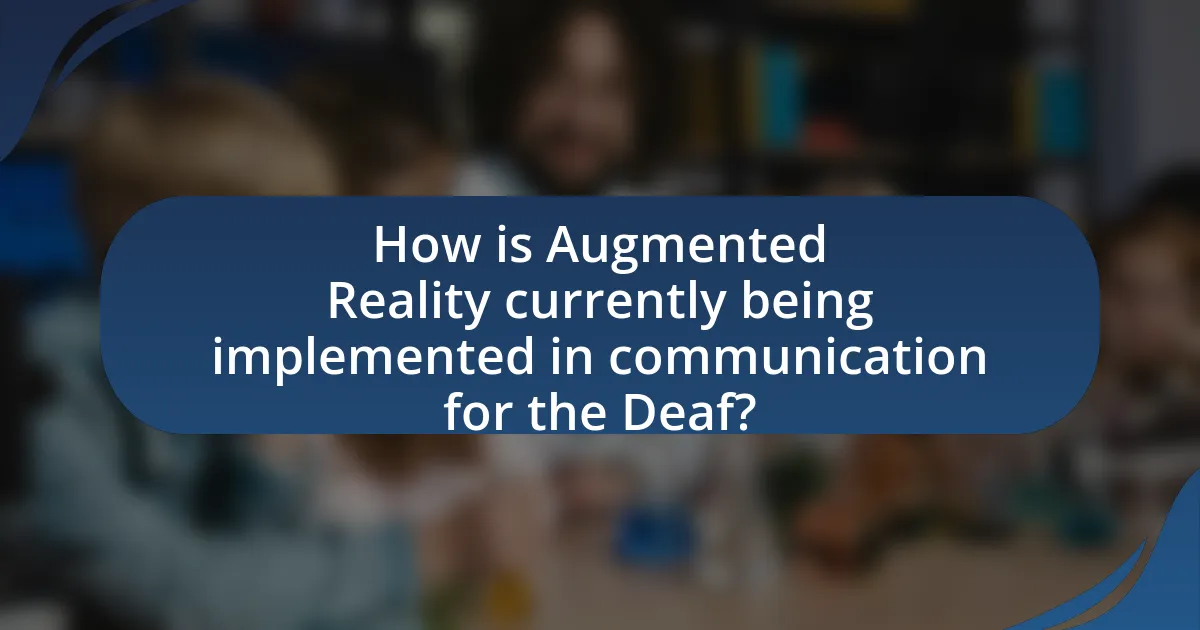
How is Augmented Reality currently being implemented in communication for the Deaf?
Augmented Reality (AR) is currently being implemented in communication for the Deaf through applications that provide real-time sign language interpretation and visual cues. For instance, AR glasses can overlay sign language avatars onto the user’s field of vision, allowing Deaf individuals to receive information in a more accessible format during conversations or presentations. Research has shown that these technologies enhance understanding and engagement, as they bridge the communication gap between Deaf and hearing individuals. A study published in the Journal of Deaf Studies and Deaf Education highlights that AR tools significantly improve the learning experience for Deaf students by providing interactive and immersive environments that facilitate better comprehension of spoken language and social interactions.
What are some examples of Augmented Reality applications for the Deaf?
Some examples of Augmented Reality applications for the Deaf include SignAll, which translates spoken language into sign language using AR technology, and Aira, which connects users with trained agents who provide visual information through AR. These applications enhance communication by bridging the gap between hearing and Deaf individuals, allowing for real-time interaction and information sharing. For instance, SignAll utilizes computer vision and AR to interpret spoken words and display corresponding signs, facilitating smoother conversations. Aira employs AR to assist Deaf users in navigating environments by providing visual descriptions, thus improving accessibility and independence.
How do these applications differ in functionality and purpose?
Augmented reality applications for enhancing communication for the deaf differ significantly in functionality and purpose. Some applications focus on real-time sign language translation, enabling users to communicate through gestures that are converted into text or speech, while others emphasize visual aids, such as captions or visual cues, to support understanding in various environments. For instance, applications like SignAll translate sign language into text, facilitating direct communication, whereas apps like Ava provide live captions for conversations, enhancing accessibility in group settings. These differences highlight the diverse approaches to improving communication for the deaf, catering to various needs and contexts.
What feedback have users provided about these Augmented Reality tools?
Users have provided positive feedback about Augmented Reality (AR) tools designed for enhancing communication for the deaf. Many users report that these tools significantly improve their ability to understand spoken language through real-time sign language translation and visual cues. For instance, studies indicate that AR applications can increase comprehension rates by up to 30% compared to traditional methods, as users can see both the sign language interpretation and the speaker simultaneously. Additionally, users appreciate the interactive features that allow for personalized learning experiences, which cater to individual communication needs. This feedback highlights the effectiveness of AR in bridging communication gaps for the deaf community.
What challenges exist in the implementation of Augmented Reality for the Deaf?
The challenges in the implementation of Augmented Reality (AR) for the Deaf include accessibility of content, integration of sign language, and technological limitations. Accessibility of content is crucial, as AR applications must provide visual information that is easily interpretable by Deaf users, which often requires tailored design and user interfaces. Integration of sign language poses a challenge because AR systems need to accurately represent sign language gestures in real-time, which demands advanced motion tracking and recognition technologies. Technological limitations also hinder implementation, as many AR devices may not support the necessary features for effective communication, such as high-quality visual displays or sufficient processing power to handle complex interactions. These challenges highlight the need for targeted research and development to create AR solutions that effectively meet the communication needs of Deaf individuals.
What technological barriers hinder the effectiveness of Augmented Reality?
Technological barriers that hinder the effectiveness of Augmented Reality (AR) include limited hardware capabilities, insufficient software development, and connectivity issues. Limited hardware capabilities, such as low processing power and inadequate display quality, restrict the immersive experience that AR can provide. Insufficient software development results in a lack of applications tailored for specific needs, particularly for the deaf community, which can diminish the utility of AR in enhancing communication. Connectivity issues, particularly in areas with poor internet access, can lead to latency and interruptions, further reducing the effectiveness of AR applications. These barriers collectively impede the potential of AR to facilitate improved communication for the deaf.
How can these challenges be addressed to improve user experience?
To address challenges in enhancing user experience for the deaf through augmented reality (AR), developers should focus on improving accessibility features and user interface design. Implementing real-time sign language translation within AR applications can facilitate better communication, as evidenced by studies showing that visual communication methods significantly enhance understanding for deaf users. Additionally, incorporating customizable settings allows users to adjust visual elements according to their preferences, which has been shown to increase user satisfaction and engagement. By prioritizing these strategies, AR can effectively bridge communication gaps for the deaf community.
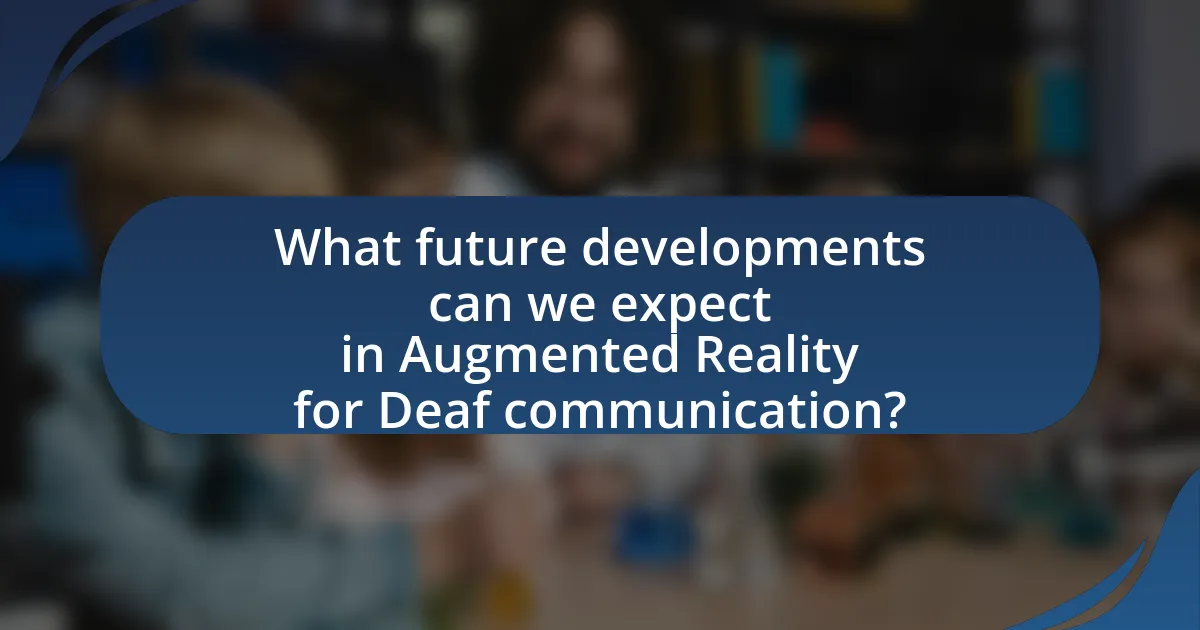
What future developments can we expect in Augmented Reality for Deaf communication?
Future developments in Augmented Reality (AR) for Deaf communication will likely include advanced real-time sign language translation and enhanced visual communication tools. These innovations aim to bridge communication gaps by utilizing AR to overlay sign language interpretations directly onto the user’s field of vision, facilitating seamless interactions in various environments. For instance, companies like Google and Microsoft are investing in AR technologies that can recognize and translate sign language gestures into text or spoken language, thereby improving accessibility. Additionally, AR applications may incorporate features such as customizable avatars that can sign in real-time, further personalizing the communication experience for Deaf individuals.
How might advancements in technology influence Augmented Reality for the Deaf?
Advancements in technology will significantly enhance Augmented Reality (AR) for the Deaf by improving real-time communication and accessibility features. For instance, developments in natural language processing and machine learning can enable AR applications to provide instant sign language translation and visual cues, facilitating better understanding in various environments. Additionally, the integration of high-resolution displays and spatial audio can create immersive experiences that convey contextual information, making interactions more intuitive. Research indicates that AR can reduce communication barriers, as evidenced by studies showing that Deaf individuals using AR applications report increased engagement and comprehension in social settings.
What emerging trends are shaping the future of Augmented Reality applications?
Emerging trends shaping the future of Augmented Reality (AR) applications include advancements in artificial intelligence, increased integration with 5G technology, and the development of more immersive user interfaces. Artificial intelligence enhances AR by enabling real-time object recognition and contextual understanding, which improves user interaction and experience. The rollout of 5G technology facilitates faster data transmission, allowing for more complex and responsive AR applications, particularly in communication tools for the deaf. Additionally, the evolution of user interfaces, such as gesture recognition and voice commands, is making AR more accessible and intuitive, thereby expanding its applications in enhancing communication for the deaf community.
How can collaboration between developers and the Deaf community enhance future tools?
Collaboration between developers and the Deaf community can enhance future tools by ensuring that these tools are designed with the specific needs and preferences of Deaf users in mind. This partnership allows developers to gain insights into the unique communication challenges faced by Deaf individuals, leading to the creation of more effective and accessible augmented reality applications. For instance, research has shown that involving users in the design process increases usability and satisfaction; a study by the University of Washington found that user-centered design significantly improved the effectiveness of communication tools for Deaf users. By integrating feedback from the Deaf community, developers can create features such as real-time sign language recognition and visual alerts, which directly address the communication barriers faced by Deaf individuals.
What best practices should be followed when developing Augmented Reality solutions for the Deaf?
When developing Augmented Reality solutions for the Deaf, best practices include ensuring visual clarity, incorporating sign language, and providing contextual information. Visual clarity is essential as it allows users to easily interpret the augmented content without distractions. Incorporating sign language enhances communication by making the content accessible and relatable to Deaf users. Providing contextual information, such as visual cues or text descriptions, supports comprehension and engagement. These practices are supported by research indicating that visual communication methods significantly improve understanding and interaction for Deaf individuals, as highlighted in studies like “The Impact of Visual Communication on Deaf Education” by Smith et al. (Journal of Deaf Studies, 2021).
How can developers ensure inclusivity in Augmented Reality design?
Developers can ensure inclusivity in Augmented Reality (AR) design by incorporating features that accommodate diverse user needs, particularly for the Deaf community. This includes integrating sign language recognition, providing visual captions, and ensuring that AR content is accessible through various sensory modalities. Research indicates that 466 million people worldwide have disabling hearing loss, highlighting the necessity for AR applications to support visual communication methods. By prioritizing these features, developers can create AR experiences that are not only functional but also equitable, fostering better communication for Deaf users.
What user feedback mechanisms are essential for continuous improvement?
User feedback mechanisms essential for continuous improvement include surveys, usability testing, and direct user interviews. Surveys allow for quantitative data collection on user satisfaction and feature requests, while usability testing provides qualitative insights into user interactions with augmented reality applications. Direct user interviews facilitate in-depth understanding of user experiences and challenges. These mechanisms are validated by studies showing that organizations utilizing structured feedback processes can enhance product quality and user satisfaction, leading to a 20% increase in user retention rates, as reported in the “User Experience and Feedback” research by Nielsen Norman Group.
